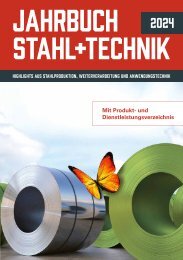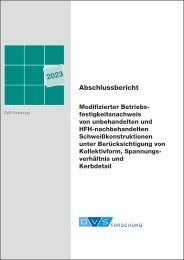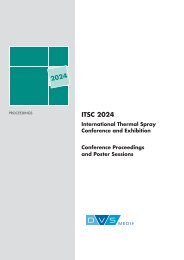STEEL + TECHNOLOGY 04/2019 EXTRACT
STEEL + TECHNOLOGY 04/2019 EXTRACT
STEEL + TECHNOLOGY 04/2019 EXTRACT
Create successful ePaper yourself
Turn your PDF publications into a flip-book with our unique Google optimized e-Paper software.
Figure 2<br />
<strong>STEEL</strong> <strong>TECHNOLOGY</strong> | 43<br />
Plant overview<br />
In the first phase BRS installed the steelmaking<br />
plant, a one strand CSP ® plant with<br />
a capacity of 1.5 million t/ year, one pickling<br />
line/tandem cold mill (PL/TCM), a continuous<br />
annealing and hot dip galvanizing<br />
line, batch annealing furnaces and an<br />
offline skin pass mill (figure 1).<br />
The overall layout is based on a “U”<br />
shape and enables short distances<br />
between the facilities as well as simple<br />
coil handling. In order to ensure flexible<br />
response to market demands, the plant is<br />
built in a way that BRS can obtain products<br />
for sale after various stages of the overall<br />
process (figure 2).<br />
The steel making plant consists of a<br />
direct current electrical arc furnace with a<br />
tapping weight of 150 t. Charge material<br />
includes commercial scrap grades and –<br />
depending on the steel grade produced,<br />
pig iron, DRI or HBI. For metallurgical refining<br />
and alloying a ladle furnace is used<br />
designed as twin station with joint electrodes<br />
to reduce idle time due to ladle handling.<br />
Also for vacuum treatment a Ruhrstahl-Heraeus<br />
(RH) degasser is installed<br />
with TOP lance for forced decarburization<br />
and chemical heating. The RH degasser<br />
has a capacity of 145 t per ladle. The process<br />
is characterized by short treatment<br />
time and flexible ladle handling. This gives<br />
BRS the opportunity of economical mass<br />
production of high-quality steel grades<br />
with ultra-low carbon and low gas content.<br />
The combination of EAF and RH degasser<br />
is the first one in North America.<br />
The CSP ® plant is designed to produce<br />
strips with a width of up to 1,930 mm (76”)<br />
and a final thickness between 1.4 mm and<br />
25.4 mm. The CSP ® Caster is a vertical<br />
solid bending (VSB) type. Slab thickness is<br />
85 mm which can be flexibly reduced<br />
down to 55 mm by liquid core reduction<br />
(LCR). The caster is equipped with mold<br />
temperature mapping (MTM), X-Pact ® solid<br />
process model, breakout detection and<br />
electromagnetic brake (EMBR) for reduced<br />
turbulence thereby improving steel internal<br />
as well as surface quality.<br />
The CSP ® furnace was designed to minimize<br />
energy consumption and to nevertheless<br />
achieve ideal heating-through of<br />
the thin slabs. The entire roller hearth furnace<br />
is equipped with environmentally<br />
compatible ultra-low NO x burners. At a<br />
measured average NO x emission of 85<br />
mg/Nm³. The furnace of Big River Steel<br />
HRC<br />
0.433 m t/year<br />
HRC P&O<br />
0.127 m t/year<br />
CAL/CGL<br />
Steelmaking plant<br />
CSP® plant<br />
Pickling line<br />
CRC galvanized<br />
0.476 m t/year<br />
Tandem cold mill<br />
BAF<br />
CRC tempered<br />
0.464 m t/year<br />
Figure 2. Phase 1 configuration and material flow at Big River Steel (Picture: SMS group)<br />
sets a standard with regard to environmental<br />
compatibility. This emission level is far<br />
below the statutory limit value.<br />
Slab transport through the furnace is<br />
carried out by water-cooled rollers with a<br />
special insulation. These rollers reduce the<br />
energy loss by more than 30% in comparison<br />
with conventional rollers. This significant<br />
increase in energy efficiency reduces<br />
the gas consumption and hence allows<br />
saving of operating costs. The overall<br />
reduction of energy consumption in the<br />
furnace is more than 20%. Energy consumption<br />
of the furnace when fed with<br />
slabs with a cross-section of 65 mm x<br />
1800 mm and a casting speed of 5.0 m/<br />
Table 1. Specific energy consumption for different slab dimensions<br />
Slab dimensions and<br />
casting speeds<br />
65 mm x 1,600 mm<br />
4.0 m/min<br />
65 mm x 1,800 mm<br />
4.5 m/min<br />
65 mm x 1,800 mm<br />
5.0 m/min<br />
Mass flow<br />
in t/h<br />
TM<br />
minute is as low as 35.2 kWh/t over 100<br />
m of furnace length (table 1). The control<br />
of the furnace uses the powerful X-Pact ®<br />
Dynamic Furnace Control Model (DFC).<br />
This model ensures the heating of the slab<br />
to the desired temperature at a high<br />
degree of uniformity over length, width<br />
and thickness.<br />
The 6-stand CSP ® rolling mill is fitted<br />
with all technologies and components for<br />
the cost-effective production of high-quality<br />
hot strip with excellent product tolerances.<br />
These include the advanced guiding<br />
system to improve strip stirring, the<br />
latest descaling technology, hydraulic<br />
gauge adjustment, CVC plus ® technology,<br />
189 0.542<br />
240 0.421<br />
267 0.352<br />
Specific energy<br />
consumption<br />
in kWh/(t m)<br />
Novembe<br />
All rights re<br />
<strong>STEEL</strong> + <strong>TECHNOLOGY</strong> 1 (<strong>2019</strong>) No. 4


















